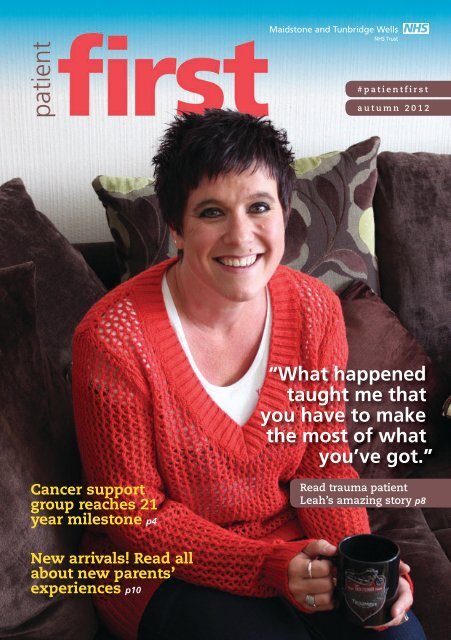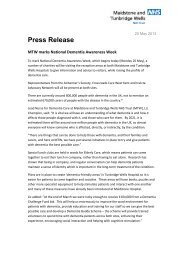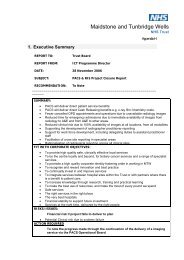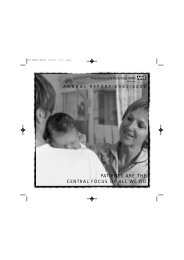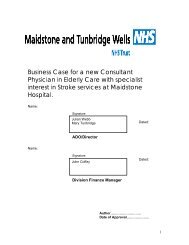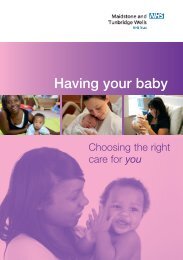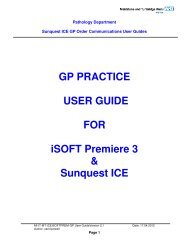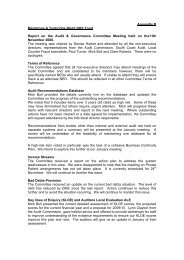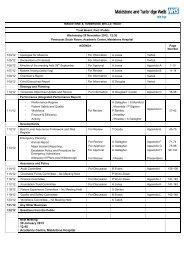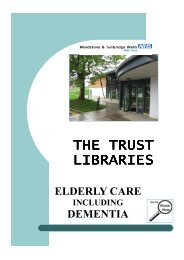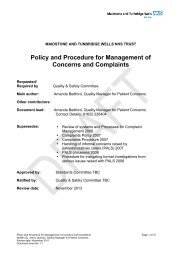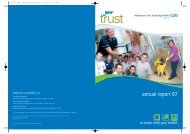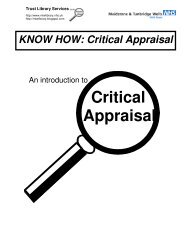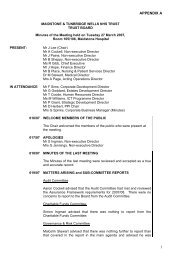Patient First - Autumn 2012 edition - Maidstone and Tunbridge Wells ...
Patient First - Autumn 2012 edition - Maidstone and Tunbridge Wells ...
Patient First - Autumn 2012 edition - Maidstone and Tunbridge Wells ...
Create successful ePaper yourself
Turn your PDF publications into a flip-book with our unique Google optimized e-Paper software.
#patientfirstautumn <strong>2012</strong>“What happenedtaught me thatyou have to makethe most of whatyou’ve got.”Cancer supportgroup reaches 21year milestone p4Read trauma patientLeah’s amazing story p8New arrivals! Read allabout new parents’experiences p10
patientfirstWelcome to thesecond <strong>edition</strong> of<strong>Patient</strong> <strong>First</strong>!September 21 st marked a whole year since ourhospital at <strong>Tunbridge</strong> <strong>Wells</strong> officially opened– <strong>and</strong> what a year it has been. Across bothour hospitals, we saw more than 119,000patients in A&E, treated around 102,000 inpatients<strong>and</strong> held over 418,000 appointmentsfor outpatients (including appointments atclinics outside the two main hospitals), not tomention the 5,500 plus babies born. It’s beena very busy, but very exciting 12 months.In this autumn <strong>edition</strong> of <strong>Patient</strong> <strong>First</strong>, youcan read the amazing story of Leah Debus– the first trauma patient to be treated at<strong>Tunbridge</strong> <strong>Wells</strong>, on the day the hospitalofficially opened; plus there are first-h<strong>and</strong>accounts from a number of new Mums <strong>and</strong>Dads who had their babies at the <strong>Maidstone</strong>Birth Centre <strong>and</strong> at the <strong>Tunbridge</strong> <strong>Wells</strong>Maternity Unit; <strong>and</strong> a range of other newsto keep you up to date with what has beengoing on at your hospitals.We hope you enjoy this br<strong>and</strong> new <strong>Patient</strong><strong>First</strong> magazine – as always, we would love tohear your feedback <strong>and</strong> your stories, so pleaseget in touch. See you again in winter!Contentsp5p11p133 One year onRead an overview about <strong>Tunbridge</strong> <strong>Wells</strong> Hospital’s firstyear from Chief Executive Glenn Douglas.4 News from your hospitalsRead articles about Crafty Chin Wagger’s hospital projects,the state of the art training facilities within the Trust <strong>and</strong>a recent garden makeover at <strong>Maidstone</strong>.8 Cover feature - Leah’s storyRead the incredible story of Leah Debus who was involvedin a serious traffic collision which changed her life forever.10 Parent featuresHear all about the experiences of three sets of parents whohad their babies at <strong>Maidstone</strong> Birth Centre <strong>and</strong> <strong>Tunbridge</strong><strong>Wells</strong> Maternity Unit.13 Maternity art projectFind out how two local photographers came to have theirwork displayed in <strong>Tunbridge</strong> <strong>Wells</strong> hospital.14 <strong>Autumn</strong> eatingGet in the mood for darker evenings <strong>and</strong> colder weatherwith these irresistible autumnal recipes.The <strong>Patient</strong> <strong>First</strong> teamContactsIf you have a story to tell us, please contact us.Communications Team: 01622 225858Communications email: mtw-tr.communications@nhs.netFor any general enquiries or advice, please contactour Trust switchboard or visit our website.<strong>Maidstone</strong> <strong>and</strong> <strong>Tunbridge</strong> <strong>Wells</strong>NHS Trust switchboard: 0845 155 1000Website: www.mtw.nhs.ukFind us @MTWnhs #patientfirstLike us <strong>and</strong> join in the conversationwww.facebook.com/mtwhospitals2www.mtw.nhs.uk/patientfirst
patientfirstA YEAR ONAyear on from the openingof our new <strong>Tunbridge</strong> <strong>Wells</strong>Hospital, <strong>and</strong> I have to say,I think things have gone very well.There were always going to beteething problems, but I think 12months down the line, the majorityof these have been ironed out <strong>and</strong>we are working hard to ensurethat our patients receive the bestpossible care.As we all remember, a year agothere was a lot of controversy overthe moving of the main Women’s<strong>and</strong> Children’s Services, includingmaternity, to <strong>Tunbridge</strong> <strong>Wells</strong>.In actual fact, this transition hasgone particularly well, with morethan 5,000 babies being bornat <strong>Tunbridge</strong> <strong>Wells</strong> in the lastyear, <strong>and</strong> the popularity of the<strong>Maidstone</strong> Birth Centre growingby the minute. To put that intocontext, we thought in the firstyear of the Birth Centre beingopen, we would have around 200babies born there. We have almostdoubled that expectation withnearly 400 babies having been bornat the centre since last September.Feedback has been exceptionallypositive <strong>and</strong> the popularity of thecentre shows that we have retainedthe loyalty of the vast majority ofmothers to be who live in the areaour Trust serves. You can read moreGlenn Douglas, Chief Executiveabout some of ourMums’ <strong>and</strong> Dads’experiences furtheron in the magazine.Another area ofdebate, initially,was the focusing ofTrauma treatmentbeing at <strong>Tunbridge</strong><strong>Wells</strong>. Again, thishas actually beenreally successful.However, from atrauma perspective, we are seeingreduced mortality rates <strong>and</strong> thatis down to the way the service isbeing run <strong>and</strong> the way traumapatients are being treated <strong>and</strong>cared for. Again, you might wantto read Leah Debus’s story in this<strong>edition</strong> of <strong>Patient</strong> <strong>First</strong> – she was infact our first Trauma patient at thenew <strong>Tunbridge</strong> <strong>Wells</strong> Hospital.A&E has been extremely busy<strong>and</strong>, particularly at <strong>Tunbridge</strong><strong>Wells</strong>, we have seen far morepatients than we could haveanticipated so it hasn’t beenwithout its ups <strong>and</strong> downs. Thatsaid, it’s going well <strong>and</strong> we areworking hard to make sure A&Eat both hospitals runs smoothly.An innovative measure we havetaken to help that process is thepublishing of A&E average waitingtimes on our website – <strong>and</strong>we’ve had really positive feedbackabout it.Overall, feedback, in general,about the new hospital has beenvery good <strong>and</strong> those who visitfrom around the country from aprofessional point of view, are quiteenvious of the facilities we’ve got.I think we would all agree that thenew <strong>Tunbridge</strong> <strong>Wells</strong> Hospital, is ahuge step forward from the old Kent<strong>and</strong> Sussex <strong>and</strong> Pembury Hospitals<strong>and</strong> in the main, the last twelvemonths have gone far better thanI perhaps thought they would, withsome real success stories for ourTrust. However, there’s no room forcomplacency so we will always aimto ensure that every one of you, ourpatients <strong>and</strong> visitors, have a goodexperience <strong>and</strong> the best possible carewe can provide in the future.<strong>Maidstone</strong> sitedevelopment<strong>Patient</strong>s will benefit from higherst<strong>and</strong>ards of care at <strong>Maidstone</strong>Hospital in the future thanks toambitious redevelopment <strong>and</strong>improvement plans.<strong>Maidstone</strong> <strong>and</strong> <strong>Tunbridge</strong> <strong>Wells</strong>NHS Trust has agreed a £20 millionplan that will modernise the 30-yearoldsite <strong>and</strong> enhance patient services.A new £2.9 million UrgentMedical <strong>and</strong> Ambulatory Unitopens this year. The unit promisesto provide fast-track diagnosis <strong>and</strong>treatment for patients with urgentmedical problems.Work starts next year on oneof the biggest projects the hospitalhas seen to modernise its medical<strong>and</strong> surgical wards. The six-yearprogramme of works will createmore single rooms <strong>and</strong> discrete fourbeddedbays for patients, improvingprivacy <strong>and</strong> dignity.Other service improvements arealso planned to ensure <strong>Maidstone</strong>Hospital continues to remain one ofKent’s key providers of healthcare.Watch out for a special exclusivelook at these developments in thenext <strong>edition</strong> of <strong>Patient</strong> <strong>First</strong>.autumn <strong>2012</strong>3
patientfirstNEWS FROM YOURCrafty Chin Waggers offersupport to cancer patientsCrafty Chin Waggers was thebrainchild of two friends who wantedsomewhere to meet up, chat <strong>and</strong>participate in some craft projects.The group was established in March2009 <strong>and</strong> over time, has grown fromapproximately 16 members to around37, with an additional 40 peoplesupporting the group from home.Crafty Chin Waggers provides a safe,relaxed <strong>and</strong> friendly meeting place forpeople in <strong>and</strong> around Mereworth tocome together <strong>and</strong> take part in crafts<strong>and</strong> projects, such as the making ofheart-shaped cushions for breastcancer patients.Fiona Andersen, Breast Care NurseSpecialist, based at <strong>Maidstone</strong> Hospital,said: “The cushions are used by womenwho have had mastectomies, breastreconstruction <strong>and</strong> lymph gl<strong>and</strong>sremoved from their armpits. Men alsoreceive the cushions after mastectomies,but these are normally rectangularrather than heart shaped <strong>and</strong> in plainer,more neutral colours.“The cushions, which are beautifullymade, provide physical comfort as theyhelp to prevent the arm rubbing onthe new wounds <strong>and</strong> are very muchappreciated by our patients who aretouched that someone cares <strong>and</strong>has thought about them duringa difficult time.”Pamela Lippett who set upthe group with her friend TinaReynolds, said: “Our membersbuy <strong>and</strong> donate all of thematerials used for making thehearts <strong>and</strong> do not take anyreimbursement. They do thisbecause they enjoy the project <strong>and</strong> cansee how much good is done by thoseinvolved in caring for cancer patients.“The project has also involved thosewith no previous sewing experience<strong>and</strong> it has been really rewarding forthem to learn a new skill <strong>and</strong> producesomething which will be of real benefitto someone else.”Previously the group has alsosupported <strong>Maidstone</strong> <strong>and</strong> <strong>Tunbridge</strong><strong>Wells</strong> NHS Trust by knitting clothes forpremature babies.Crafty Chin Waggers is a self-fundinggroup <strong>and</strong> through fundraising efforts,the group has been able to purchasethree sewing machines. However,donations of machines, fabric <strong>and</strong> othercraft materials are always welcome <strong>and</strong>very much appreciated. If you haveitems to donate, please contact Pamelaby email on:pamelalippett@craftychinwaggers orvisit the group’s website at:www.craftychinwaggers.comNew members are always welcome!Party to celebratemilestone birthday ofcancer support groupOn Saturday 11 August, <strong>Maidstone</strong>Hospital’s Breast Care Support Groupcelebrated its 21st ‘birthday’ by way ofa party, which was held in the AcademicCentre at the hospital.The group, which has been runningsince 1991, was established by breastcare nurse specialist Pam Wright <strong>and</strong>patient Sadie Sharp. Since its creation,the group has been well attended<strong>and</strong> supported, with between 20-40attendees at each session.The group meets once a month, fortwo hours on a Saturday morning <strong>and</strong>often a speaker is arranged to ensurethe sessions are interesting, informative<strong>and</strong> useful to those who attend. Talkshave covered a wide range of topics,including acupuncture, reflexology, arttherapy <strong>and</strong> philosophy. In addition,the Breast Care Nurse Specialists from<strong>Maidstone</strong> <strong>and</strong> <strong>Tunbridge</strong> <strong>Wells</strong> NHSTrust attend every session <strong>and</strong> are onh<strong>and</strong> to answer questions <strong>and</strong> supportthe group as they are needed.To celebrate the l<strong>and</strong>mark birthday,decorations were put up <strong>and</strong> the groupenjoyed a buffet, a glass of bubbly <strong>and</strong>a special cake, plus a toast was given byPeter Jones who attended with his wifeSue Jones. Both are consultant breastsurgeons based at the <strong>Maidstone</strong> <strong>and</strong><strong>Tunbridge</strong> <strong>Wells</strong> Breast Clinic <strong>and</strong> havesupported the group for many years.If you would like to find out moreabout the group, or are interested inattending, please phone 01622 225743.Thank you!A huge thank you toeveryone who came alongto the League of Friends Funday at <strong>Maidstone</strong> Hospital on8 September – you helped toraise over £4,000!Last month’scrossword answers4www.mtw.nhs.uk/patientfirst
patientfirstHOSPITALSState of the art facilitiesfor medical staff to testtheir practical skillsHave you ever wondered how amedical professional first starts topractice suturing, or intubation or evenkeyhole surgery?The answer lies within the ClinicalSkills Rooms <strong>and</strong> Dinwoodie SimulationSuite at <strong>Tunbridge</strong> <strong>Wells</strong> Hospital<strong>and</strong> within the Academic Centre at<strong>Maidstone</strong> Hospital.The state of the art facilities offerjunior doctors, medical students,nurses, midwives <strong>and</strong> other healthcareprofessionals the chance to ‘try out’their skills on artificial limbs, heads,<strong>and</strong> even interactive manikins (a lifesizedanatomical human model usedin education).Epidurals can be practised on artificialbacks, a range of chest sounds canbe listened to via an artificial torso,intravenous cannulation can be doneon a prosthetic arm <strong>and</strong> pads of ‘skin’can be used for suturing.However, possibly the most realistictraining can be given in the DinwoodieSimulation Suite where an interactivemanikin, who breathes, blinks <strong>and</strong>has a heartbeat <strong>and</strong> pulse, lies in bedwaiting for treatment. His conditioncan be controlled from a roomadjoining the suite, <strong>and</strong> he can speak,groan in pain <strong>and</strong> dem<strong>and</strong> thingsfrom those treating him. The manikinis hooked up to equipment whichmonitors his heart rate <strong>and</strong> oxygenlevels <strong>and</strong> these can also be controlledto simulate real situations which couldoccur, to spontaneously test the stafftaking part in the trainingexercise.Emma Moran,Simulation Facilitator for<strong>Maidstone</strong> <strong>and</strong> <strong>Tunbridge</strong><strong>Wells</strong> NHS Trust said:“The equipment wehave in the ClinicalSkills Rooms allowstaff the opportunityto practice specific skillssuch as suturing, catheterisation <strong>and</strong>cannulation. However, the simulationsuite allows the skills of an entire teamto be practiced <strong>and</strong> tested, not onlyfrom a clinical point of view but justas importantly from a communicationspoint of view – all in a pressurisedenvironment. It’s the closest anyhealthcare professional can get to areal life situation <strong>and</strong> therefore anexcellent way of helping them developtheir practical skills, decision making<strong>and</strong> team work.”Dr Paul Moran, ConsultantAnaesthetist <strong>and</strong> Trust, lead forsimulation, said: “We are very proudof the training facilities we have atboth <strong>Maidstone</strong> <strong>and</strong> <strong>Tunbridge</strong> <strong>Wells</strong>Hospitals – we have the very bestequipment to ensure our staff receivethe best possible training so we canmaintain <strong>and</strong> improve the safety ofour patients.“While the Trust has made significantinvestment into the equipment wehave, we were also very lucky to receive£150,000 funding from The DinwoodieCharity, who assists the medicalprofession in Engl<strong>and</strong> by enhancing theopportunities for postgraduate Medicaleducation <strong>and</strong> training.”The Academic Centre at <strong>Maidstone</strong>Hospital, which opened in June 2010,also provides facilities for training<strong>and</strong> learning. It houses the <strong>Maidstone</strong>simulation suite, where multidisciplinarysimulation training is already takingplace. The centre also includes a 150seat tiered auditorium which can linkup to other facilities around the world,teaching rooms, libraries <strong>and</strong> offices.The International Minimal AccessCentre for Surgery (IMACS) is alsobased within the Centre.Dr Moran added: “We are currentlylooking at exp<strong>and</strong>ing the facilities wehave at <strong>Maidstone</strong>, to replicate some ofthe new equipment we have availablein the Clinical Skills Rooms at <strong>Tunbridge</strong><strong>Wells</strong> – <strong>and</strong> we hope to be able to dothis within the next year or so.“Good training translates directlyinto better care for patients. Ourfacilities in both hospitals give usoutst<strong>and</strong>ing facilities for teaching <strong>and</strong>learning which will hopefully appealto medical trainees from all over theworld, <strong>and</strong> encourage them to workfor our Trust, <strong>and</strong> to provide the bestpossible care for our patients.”Grammar school students attend hospital careers dayA group of 47 AS & A-level students from Invicta Grammar School in <strong>Maidstone</strong>spent a day at <strong>Tunbridge</strong> <strong>Wells</strong> Hospital in September to find out more aboutpotential careers in healthcare <strong>and</strong> medicine.The students heard <strong>and</strong> took part in presentations, workshops <strong>and</strong> practicalactivities involving doctors, nurses, midwives, allied health professionals <strong>and</strong>administrative staff, who are all keen to encourage a new generation into thehealth service.The practical sessions took place in the facilities described in the article above sothe students were able to observe demonstrations of specialist training equipment<strong>and</strong> clinical activities, such as how to take a blood sample, as well as participate inpractical sessions, including resuscitation skills on some of the training dummies.Lost somethingIf you have recentlyattended one of ourhospitals <strong>and</strong> have losta personal item, pleasecontact the HospitalServices Manager, PhilDwyer, on: 01892 633680as many items are h<strong>and</strong>edin <strong>and</strong> can be claimed backby the owner.autumn <strong>2012</strong>5
patientfirstmoreNEWS FROM YOUR HOSPITALSFormer Matron, 90, visits<strong>Tunbridge</strong> <strong>Wells</strong> Hospitalto see how things havechanged since she startednursing in the 1940sStaff at <strong>Tunbridge</strong> <strong>Wells</strong> Hospitalheard a first-h<strong>and</strong> account of hownursing has changed since the SecondWorld War, when former Kent & SussexHospital <strong>and</strong> Pembury Hospital Matron,Joan Page, came to visit.Miss Page, who is now 90, was givena tour of the Hedgehog Children’s Ward<strong>and</strong> was also able to look round otherparts of the hospital before meetingwith <strong>Maidstone</strong> <strong>and</strong> <strong>Tunbridge</strong> <strong>Wells</strong>Chief Executive, Glenn Douglas.She was shown around the hospitalby Emergency Planning Manager,John Weeks, who is currently writinga book about the history of ourhospitals, <strong>and</strong> Claire Spence, <strong>Patient</strong>Experience Matron.In Hedgehog Ward, Miss Page spokewith Rochelle Gilder, who runs the unit.She was shown the single rooms withinthe ward, the play areas for the children<strong>and</strong> the high dependency rooms. Sheparticularly liked the murals in the ward,which were designed by a 14 yearold student last year after she won acompetition with her artistic efforts.Miss Page said: “I did my children’straining in 1942 in the Queen ElizabethChildren’s Hospital in Hackney, London,during the war. We treated childrenfor almost everything – measles,pneumonia, rubella <strong>and</strong> of courseinjuries, some sustained as a result ofthe war going on. You never reallyknew what you would be faced with.“Medicines such as antibiotics <strong>and</strong>steroids were not readily available untilafter the war so we were faced withsome big challenges in terms of treatingour patients, <strong>and</strong> of course we also hadvery little equipment to help us.“And it wasn’t just the treatmentwhich was very different to how thingsare now, we were also very limited inthe facilities we had.”Miss Page moved from the QueenElizabeth to Guy’s Hospital in 1945 <strong>and</strong>then in 1949, she joined the Royal FreeHospital as a Sister.Miss Page added: “When I was at theRoyal Free Hospital, generally, parentswould come to visit their children inhospital once a week on a Sunday,because many of them lived in thecountry <strong>and</strong> it was very difficult totravel in to London on a regular basis.“There were no playrooms either,children had to play with each otheron the ward, <strong>and</strong> occasionally, ifsome children were not going to bereceiving visitors, I would take themto my office <strong>and</strong> we would have atea party.“I think the play rooms in Hedgehog building <strong>and</strong> a lot of thought has beenWard are wonderful <strong>and</strong> it’s good that put in to the facilities within it.parents can stay with their children in “And as a recent orthopaedic patient,the single rooms.”I am pleased to say the staff are splendidWhile at the Royal Free Hospital, Miss <strong>and</strong> the food is absolutely wonderful!”Page was given permission to work in <strong>Maidstone</strong> <strong>and</strong> <strong>Tunbridge</strong> <strong>Wells</strong> NHSDenmark for six months. A few years Trust Chief Executive, Glenn Douglas,later, she made her move from London said: “We were delighted to welcometo Kent.Miss Page to our hospital <strong>and</strong> it wasShe joined Kent & Sussex Hospital as fascinating to hear from someone withDeputy Matron from 1958, <strong>and</strong> then in so much experience, in so many different1962, took over as Matron.aspects of nursing.Shortly after her appointment, the“The stories she told us were notGeneral Medical Council carried out anonly fascinating but sobering tooinspection of hospitals in the area <strong>and</strong>when you think of the lack of medicinedecided there could only be one training<strong>and</strong> equipment available to medicalschool in <strong>Tunbridge</strong> <strong>Wells</strong>. As a result,professionals during <strong>and</strong> after the war.Kent & Sussex <strong>and</strong> Pembury Hospitals“We are very lucky to have suchwere amalgamated <strong>and</strong> Miss Pagefantastic facilities in our area <strong>and</strong> as abecame Matron of both.Trust, we want to use them to maximumMiss Page worked a variety of longbenefit <strong>and</strong> ensure we constantly aim toshifts, as well as interviewing <strong>and</strong>improve our services <strong>and</strong> our patients’training new members of staff. Sheworked many Christmas Days <strong>and</strong> wouldexperiences.”always ensure she saw each patient ineach hospital, personally – around 700of them.Follow us!And perhaps that’s not a surpriseOur Facebook <strong>and</strong> Twitter sites arecoming from someone who decided gradually building friends <strong>and</strong> followerson a career in nursing when she was a but we would like more, so pleaselittle girl.join us!Miss Page said: “I decided I wanted You can join us on Facebook byto be a nurse following a serious bout searching for ‘<strong>Maidstone</strong> <strong>and</strong> <strong>Tunbridge</strong>of pneumonia when I was 10 years old. <strong>Wells</strong> NHS Trust’ or alternatively, you“Unbelievably, I was taken ill with it can go to: www.facebook.com/again two weeks into my career as a mtwhospitalsnurse but I recovered <strong>and</strong> thoroughly And on Twitter @MTWnhsenjoyed my chosen profession,You can find out about what we’veparticularly the interaction withbeen up to <strong>and</strong> see lots of our latestpatients <strong>and</strong> the training <strong>and</strong> teaching photos. A recently added album to ouraspect too.Facebook page shows old photos found”I think the new <strong>Tunbridge</strong> <strong>Wells</strong> in our archives, some of which areHospital is worlds apart from what I was of the Kent <strong>and</strong> Sussex <strong>and</strong> Pemburyused to during my career, but it’s a lovely Hospitals during the Second World War.6www.mtw.nhs.uk/patientfirst
patientfirstHospital gardengets a makeoverOne of the courtyard gardens at<strong>Maidstone</strong> Hospital has undergone amakeover, thanks to a group of localyoung people.The Year 11 students (aged 15 <strong>and</strong>16) became involved in the projectvia the government-led NationalCitizen Service initiative which isbeing run by the charity CXK in Kent& Medway, in partnership with theNational Youth Agency <strong>and</strong> 02 ThinkBig. The project aims to support youngpeople to develop their life skills, takeon new challenges <strong>and</strong> encouragethem to become more involved intheir local community.Through information <strong>and</strong> talks givenat local schools, these students <strong>and</strong>others, chose to get involved in theprogramme when they finished schoolearlier this year.All seven young people who workedon the garden were from differentschools across <strong>Maidstone</strong> <strong>and</strong> <strong>Tunbridge</strong><strong>Wells</strong> <strong>and</strong> did not know each other priorto getting involved in the project.After an induction day to meet oneanother, the young people spent fivedays on a residential adventure coursein Yorkshire where they learnt teambuilding skills <strong>and</strong> became involvedin other outdoor activities.On their return, the youngpeople were given five daysto plan their project, whichhad to be of benefit to their localcommunity.The result was the gardenproject at <strong>Maidstone</strong> Hospital.afterBethan Gorvett, one of the teamleaders overseeing the project, said:“The young people have really enjoyedworking on this project to improvethe courtyard garden <strong>and</strong> we hope itwill bring some joy <strong>and</strong> happiness topatients <strong>and</strong> their families who may beexperiencing difficulties or stresses intheir lives.“In addition to the garden project,we have received some prize donations,from local shops, towards a raffle wewill be holding - proceeds from this willgo towards buying toys for paediatricpatients at the hospital.”The seven young people, Tasha (16),Dylan (16), Frankie (16), James (16),Phoebe (15), Aidan (16) <strong>and</strong> Josh (16),along with their two team leaders,Bethan Gorvett <strong>and</strong> Lara Delaney,worked at the hospital from 6 Augustto the 10 August, when the projectwas completed.Jeanette Rooke, from <strong>Maidstone</strong> <strong>and</strong><strong>Tunbridge</strong> <strong>Wells</strong> Estates Department,said: “The garden looks brilliant. It hasgone from being a mass of overgrownshrubs to being a very pretty, vibrantspace which everyone can enjoy.“We are so pleased these youngpeople chose to come here <strong>and</strong> helptheir local hospital – they have workedextremely hard on the project.”beforeBirth Centre 1 stbirthday partyOn 25 September, the <strong>Maidstone</strong> BirthCentre celebrated its 1st birthday, byway of a very well attended tea party.Many of the families who had theirbabies at the centre over the past yearcame along to help celebrate the BirthCentre’s success – over 100 in total.Staff from across the Trust also camealong to support their colleagues <strong>and</strong>enjoy the party.Birth Centre Midwife Zoe Manclarkcreated a birthday cake for the partywhich featured hundreds of tiny icingmodels of babies – in fact, there wasone icing model to represent everysingle baby born at the Birth Centre inthe last year!During the party itself, the BirthCentre welcomed another two newarrivals, both baby boys.Birth Centre birthday cakeSpecial focus on carefor dementia patients<strong>Maidstone</strong> <strong>and</strong> <strong>Tunbridge</strong> <strong>Wells</strong> NHSTrust has appointed a new Head ofNursing <strong>and</strong> lead for dementia care –Sally Smith.She will be working alongsideour clinical staff <strong>and</strong> linking in withcommunity partners such as SocialServices <strong>and</strong> mental health teams inthe area, to improve care for dementiapatients when they are admittedto hospital.Some of her main priorities include:raising awareness of dementia care,improving education <strong>and</strong> trainingfor staff who have contact withdementia patients, improving the wardenvironment for the patients, assessingpatients’ medication, facilitating timelydischarge from hospital <strong>and</strong> ongoingcommunity support.Sally said: “There is a lot to do <strong>and</strong>I am really looking forward to it. Mymain aim is to really raise the profileof dementia care so we can be assupportive as possible to ourpatients’ needs.”autumn <strong>2012</strong>7
patientfirstDetermined to liveLIFE TO THE FULLMum of two, Leah Debus, never imagined when the new hospitalat <strong>Tunbridge</strong> <strong>Wells</strong> officially opened on 21 September last year,that she would be the first trauma patient to be treated there.But a near-death motorcycle collision on the same day didn’t onlycost Leah her right leg, but also changed her life forever.“ It was just a normal day,” saidLeah, “It was a Wednesday,<strong>and</strong> Wednesdays are bike nightso we had been to the Oak Denebike café at the A20 that evening.We only stayed for about an hour<strong>and</strong> on the way home, we tookan unusual route due to a trafficaccident. I was riding my ownmotorbike <strong>and</strong> was with my partnerat the time, <strong>and</strong> two other friends.“I remember the sound of thecrash <strong>and</strong> I remember being awareof flying through the air <strong>and</strong> thenhitting the floor. The most vividmemory I have after that is ofintense pain from my ribs all theway down my right side.”Having been riding in frontof Leah, her then partner, NickyMurphy, <strong>and</strong> another friend hadridden on ahead so didn’t see theaccident happen.“My natural reaction immediatelyafter the crash was to try to get upbut my friend, Alison, who was theonly one to have seen whathappened, rushed over to me<strong>and</strong> told me to stay still. She toldme that my right leg was not ina good way <strong>and</strong> kept me calmwhile other people nearby calledfor help.“I remember being completelyterrified at that point, I didn’tknow how badly injured I was butI did know, instinctively, that it wasvery serious. I felt claustrophobicwith my helmet on but knew Ineeded to keep it on until someonehad checked me over.”Two paramedics arrived at thescene in a car shortly afterwards,by which time, Leah’s partner<strong>and</strong> other friend had also realisedsomething was wrong <strong>and</strong> hadturned round, only to get caught upin the traffic now building up as aresult of the collision Leah had beeninvolved in.The paramedics with Leah beganto check her but it was when theyremoved her motorbike leathersfrom her right leg that they realisedhow serious it was. Her leg hadsustained extensive damage - theimpact of the crash had severedthe artery in her thigh <strong>and</strong> she waslosing a lot of blood fast.“I remember hearing one ofthe paramedics calling for anambulance, saying it was urgent<strong>and</strong> that he wasn’t sure they couldget me to hospital in time. I justremember, at that point, thinking,this could be it. I might die. Iactually felt completely calm <strong>and</strong>it was then that the determinationstarted to kick in. I suddenly startedthinking about the fact that if Idied, I wouldn’t see my girls again,<strong>and</strong> the fact that my Mum neededme. I decided I just couldn’t go <strong>and</strong>if I could remain calm, that maybe itwould help me to get through it.”Leah was taken to the br<strong>and</strong> new<strong>Tunbridge</strong> <strong>Wells</strong> Hospital, whichhad officially opened earlier thesame day. There, she was rushedthrough to the Trauma Unit, whereOrthopaedic Consultant, Dr MikeFordyce, was waiting.“Mr Fordyce, my consultant,was fantastic. He was calm butcompletely honest with me <strong>and</strong> toldme that I needed to immediatelyundergo surgery to amputate myright leg. My body was shuttingdown <strong>and</strong> the surgery had to8www.mtw.nhs.uk/patientfirst
patientfirst“I received absolutelyamazing care. In fact,I cried when I left.”happen straight away. I actuallysigned my own consent form beforebeing taken to theatre. I hadn’t lostconsciousness up to that point.”Leah was in theatre for severalhours. Her right leg was amputatedabove the knee, <strong>and</strong> she wastreated for a badly bruised pelvis.She woke up in Intensive Care thefollowing day having been placedin an induced coma overnight, withher daughters Kate (16) <strong>and</strong> Laura(13) at her bedside.“I remember being so happy tosee my girls, <strong>and</strong> also, very hungry!I was moved on to the TraumaWard the following day <strong>and</strong>I spent four weeks there,recovering <strong>and</strong> undergoingphysio to help me adapt tolosing my leg.“I loved my room on theward, the privacy I had <strong>and</strong> theen-suite, <strong>and</strong> I received absolutelyamazing care. In fact, I cried whenI left. The staff had become likefamily <strong>and</strong> had helped me throughso much. The physiotherapists, inparticular, were brilliant <strong>and</strong> gotme out of bed within days of theaccident. It was really important forme to learn to adapt as quickly asI could. I have always been a veryactive person –I love horse-riding, walking, cycling,riding my motorbike <strong>and</strong> my jobwas a support worker for adultswith learning disabilities which isa surprisingly physical role. I knewfrom immediately after the accidentthat I wanted to continue to do asmany of those things as possible –including getting back ona motorbike.”After Leah left hospital, shewent to stay with her Mum for awhile <strong>and</strong> she received her firstprosthesis exactly two months afterthe crash, on 21 November, at theDisablement Service Centreat Medway Hospital.Leah said: “I had to re-learn howto walk <strong>and</strong> I had to completelytrust my prosthetic leg. Whenyou walk, you obviously can’t feelyour foot touch the floor so haveto trust that it has <strong>and</strong> that the“I had to learn how to walk<strong>and</strong> I had to completelytrust my prosthetic leg.”prosthesis will hold you up likeyour leg would have done before.It’s hard, but I was absolutelydetermined to get used to it <strong>and</strong>live my life to the full.”And that is exactly what Leah isdoing. She got back on a horsein April <strong>and</strong> in September sherode a motorcycle on herown for the first time sincethe accident. She will alsosoon be taking part in at<strong>and</strong>em parachute jump forthe organisation, ‘Bike Toursfor the Wounded’. And allthat’s not to mention the fulltime studying she has taken upto complete an access coursewhich will take her on to anEnglish Literature degree so she canfulfil her ambition to be a secondaryschool teacher.“I have always been a positiveperson but that’s even more thecase now,” said Leah, “Whathappened has made me a happierperson – I have my girls with me,<strong>and</strong> although I am no longer ina relationship with Nicky, we arestill close friends. He, my girls,my Mum, so many friends <strong>and</strong> my‘biker family’ have been a massivesupport in the last 12 months <strong>and</strong>I want to thank them all from thebottom of my heart.“They have made it somuch easier for me tounderst<strong>and</strong> that I haveto learn to do things in adifferent way now <strong>and</strong> I haveto accept my limitations.But everyone has limitations, ablebodiedor not.“What happened taught me thatyou have to make the most of whatyou’ve got. Would I go back <strong>and</strong>change what happened that day?No, I wouldn’t.”autumn <strong>2012</strong>9
patientfirstFIRST-TIME MUMSEarlier this year, two first-time mums chose to give birth to theirbabies at the <strong>Maidstone</strong> Birth Centre. Would their experiences be asthey’d hoped, or would some initial concerns turn out to be justified?Here they share their experiences…Sarah-Louise, Mark <strong>and</strong>Ruby Jessica<strong>Tunbridge</strong> <strong>Wells</strong> based Sarah-Louise <strong>and</strong> Mark Wheatleywelcomed their first child, Ruby,into the world on 18 July <strong>2012</strong>at 6.58am, one week late <strong>and</strong>weighing in at 9lbs 2oz.Sarah-Louise said, “When wediscovered I was pregnant, Mark<strong>and</strong> I assumed that the baby wouldbe born at <strong>Tunbridge</strong> <strong>Wells</strong> Hospital,as it is the closest to where welive. However, during an antenatalclass, I heard about the <strong>Maidstone</strong>Birth Centre <strong>and</strong> in order to beaware of all the options available tous, we decide to book a tour.”Sarah-Louise <strong>and</strong> Mark visitedduring one of the scheduled toursheld by the Birth Centre staff, wherethey were able to view the facilities,en-suite bedrooms <strong>and</strong> communalareas, as well as ask questions <strong>and</strong>discuss possible concerns.“We loved the homely feel of thecentre <strong>and</strong> were very impressed withthe bubbly, helpful staff we metduring the tour. We definitely bothliked the Birth Centre <strong>and</strong> I felt veryat ease there but we didn’t want torush into a decision, so we also wentto see the maternity department at<strong>Tunbridge</strong> <strong>Wells</strong> Hospital.”The couple liked the hospital <strong>and</strong>were impressed with the facilities<strong>and</strong> individual rooms available,but ultimately decided that theypreferred the environment at theBirth Centre, as they were keen toavoid the birth feeling too clinical.The relevant checks were carriedout <strong>and</strong> it was confirmed to thecouple that there seemed to be noreason why their baby shouldn’t beborn at the Birth Centre.Mark added, “As much as I lovedthe Birth Centre, part of me washoping that Sarah-Louise wouldchoose <strong>Tunbridge</strong> <strong>Wells</strong> Hospital as Ihad concerns about the transfertime from the Birth Centre, tohospital, should it be needed.”Whilst his concern wasunderst<strong>and</strong>able, Mark’sworries were unnecessary asSarah-Louise’s labour <strong>and</strong>delivery went well, with nocomplications.Sarah-Louise said, “Thefacilities are incredible <strong>and</strong>there is the most wonderfulatmosphere in the Birth Centre.There are various options to helpmanage the pain, one method beingthe birth pool. I specifically chosethe Birth Centre as I wanted to avoidpain relief, such as the epidural,which isn’t available there.”Not long after Ruby’s birth, herGr<strong>and</strong>parents were able to visit, asthe individual en-suite room set-upmeans that visitors are able to comeat a time to suit the parents, ratherthan being restricted to normalvisiting hours.“What was particularlynice, was that the samestaff stayed with Sarah-Louise throughoutlabour <strong>and</strong> they wereall fantastic.”“Our visitors were overwhelmedby the Birth Centre <strong>and</strong> made somany positive comments about itto us. As soon as they saw it, theycould underst<strong>and</strong> why we chose tohave Ruby there.“I stayed in for one night <strong>and</strong>because all the rooms are private<strong>and</strong> sleep two people, Mark wasable to stay with me, rather thanhaving to leave Ruby <strong>and</strong> I alone.”Mark said, “I was so pleased thatI got to spend Ruby’s first night withher <strong>and</strong> I wouldn’t have wantedto leave Sarah-Louise. It was reallyspecial spending the first night as afamily <strong>and</strong> I don’t think I wouldhave slept if I’d had to go home!”Both Sarah-Louise <strong>and</strong> Markbelieve that they made the rightdecision <strong>and</strong> can’t stress enoughhow wonderful the staff in the BirthCentre were.“What was particularly nice, wasthat the same staff stayed withSarah-Louise throughout labour<strong>and</strong> they were all fantastic.” saidMark. “They were comforting<strong>and</strong> reassuring <strong>and</strong> we both knewthat they wouldn’t take a risk <strong>and</strong>that if intervention was needed,they wouldn’t hesitate in seekingassistance. Sarah-Louise was reallywell looked after <strong>and</strong> the staffmade sure that we were both keptinformed <strong>and</strong> understood what wasgoing on.“Even after the birth the staffwent above <strong>and</strong> beyond, helpingSarah-Louise with breast feedingadvice.”Sarah-Louise said, “We wouldparticularly like to thank midwivesLorraine <strong>and</strong> Kelly, who broughtRuby into the world. They were bothfantastic <strong>and</strong> we are very grateful tothem.”Sarah-Louise concluded, “Myexperience at the Birth Centrewas an excellent one <strong>and</strong> bothMark <strong>and</strong> I would whole-heartedlyrecommend it to future parents. Ifwe have any more children then Iwould definitely return to the BirthCentre, should I be able to.10www.mtw.nhs.uk/patientfirst
patientfirst“I can underst<strong>and</strong> concernspeople may have <strong>and</strong> you have tobe comfortable with the decisionyou make, but I would urge othersto arrange a visit <strong>and</strong> go <strong>and</strong> seethe facilities for themselves beforemaking their decision.”Victoria, Steve <strong>and</strong>Harrison Joseph<strong>Maidstone</strong> couple Victoria <strong>and</strong>Steve Smith’s first baby, HarrisonJoseph, was born on 10 July <strong>2012</strong>at 12.06am. He weighed 7lbs1oz <strong>and</strong> was four days late. BothVictoria <strong>and</strong> Steve liked the nameHarrison, but as a huge Star Warsfan, Steve was particularly keen topay homage to the original HanSolo, Harrison Ford!Victoria said, “I’d heard aboutthe Birth Centre <strong>and</strong> was reallyintrigued to see it, so we took atour to find out more. Steve <strong>and</strong>I couldn’t believe how calm <strong>and</strong>relaxed it felt as soon as you walkedthrough the door <strong>and</strong> I loved thedécor <strong>and</strong> facilities available. Thestaff we met were lovely <strong>and</strong> I feltconfident in them <strong>and</strong> believed thatthey would look after me.“We were pretty sure that wewanted to use the Birth Centre buttowards the end of my pregnancyI started to have a few doubts<strong>and</strong> concerns. I was worried thatI would want pain relief in theform of an epidural <strong>and</strong> started towonder what would happen if Ineeded emergency treatment.”Steve added, “It was importantto me that Victoria made theultimate decision about whereto give birth as I wanted her tofeel relaxed <strong>and</strong> happy about thesituation. I did share her concernsbut I also felt confident in the“It was very much atailored service <strong>and</strong>I couldn’t have feltmore secure <strong>and</strong>relaxed.”service we would receive.”On 9 July, whilst out shopping,Victoria started to feel unwell <strong>and</strong>had to return home. After a fewhours, Victoria <strong>and</strong> Steve decidedto go to the Birth Centre to seekadvice, as they believed that labourhad started.“Once we got to the Birth Centre,I was checked by the midwife <strong>and</strong>was told that I could go home if Iwished, as I still had some time togo, but was welcome to stay if Iwould rather. We decided to stayput <strong>and</strong> got settled in our own,beautifully decorated, home-fromhomebedroom.“I used one of the birth pools<strong>and</strong> was able to give birth toHarrison in it, which was anamazing experience.“The staff were really keen to giveus the experience we wanted <strong>and</strong>asked lots of questions to ensurethat we were happy <strong>and</strong> that theyweren’t making assumptions aboutwhat we wanted. It was very mucha tailored service <strong>and</strong> I couldn’t havefelt more secure <strong>and</strong> relaxed.”Victoria <strong>and</strong> Steve were bothpleased with the decision they made<strong>and</strong> feel that the Birth Centre wasthe right choice for them.“The Birth Centre really is ahome from home, <strong>and</strong> offered usthe privacy we wanted, without usfeeling isolated. The staff are therewhen you need them but aren’tintrusive. They helped with breastfeeding <strong>and</strong> showed us the bestway to change a nappy <strong>and</strong> sinceHarrison’s birth I’ve also attended abreast feeding group which is heldin the Centre.”Steve added, “We have noregrets <strong>and</strong> our experience at theBirth Centre was exactly what wewanted. We can’t thank the staffthere enough as they were fantasticon the day <strong>and</strong> were supportive <strong>and</strong>caring following Harrison’s birth.There would be no hesitation inrecommending the Birth Centre toothers as we cannot fault it.”400 babies<strong>and</strong> counting!Consultant Midwife SarahGregson said, “The BirthCentre is a purpose builtunit, staffed by midwives, wheremothers can give birth <strong>and</strong> learnhow to care for their babies in arelaxed, home-like setting.“When plans for the Birth Centrewere being developed, it wasestimated that approximately 200women would choose to give birththere during the first year. However,one year on, <strong>and</strong> I am delighted toreport that 400 babies have beenborn there, which is testament to itsfantastic staff <strong>and</strong> facilities <strong>and</strong> thewelcoming, relaxed atmosphere.“Research shows that Birth Centresare as safe as hospitals for womenwith a straight forward pregnancy.The research also indicates thatwomen are more likely to achievea normal birth <strong>and</strong> are less likelyto require a caesarean section. Inaddition, they are also more likely tobe satisfied with their experience.“The Birth Centre is staffed byexperienced midwives, offeringone-to-one, continuous care inlabour. It has two large birthingrooms, each with a pool <strong>and</strong> plentyof birthing aids such as beanbags, birthing balls, music <strong>and</strong>complementary therapies.“There are four comfortablebedrooms, three with double beds<strong>and</strong> one with twin beds, so a familymember or friend can stay at alltimes. There is also a kitchen/diner,lounge area <strong>and</strong> a small garden forparents to use.”To find out more about the BirthCentre, as well as other maternityservices available at <strong>Maidstone</strong><strong>and</strong> <strong>Tunbridge</strong> <strong>Wells</strong> NHS Trust,please visit:www.mtw.nhs.uk/maternityThis baby girl was the 400th baby to beborn at the Birth Centre on 28 Spetember.autumn <strong>2012</strong>11
patientfirstFROM HEARTACHETO HAPPINESS…Following a number of tragedies, Glen <strong>and</strong> Eva Conway questionedwhether they would ever be fortunate enough to start a family <strong>and</strong>began to consider other options. Thanks to some first class care,they have now welcomed baby Elijah into their lives <strong>and</strong> couldn’t behappier. Here they share their emotional story…Sevenoaks based Glen <strong>and</strong>Eva Conway’s first baby wasborn on 22 August <strong>2012</strong> at4.30pm. Elijah was born followingan emergency caesarean section<strong>and</strong> weighed in at 7lbs 1oz.Glen said, “Unfortunately, it hasbeen a long <strong>and</strong> difficult journeyfor us <strong>and</strong> we have encounteredmuch heartache on the way toElijah being born.“In 2006, whilst under thecare of another Trust, Eva hada miscarriage at five months<strong>and</strong> unfortunately, her secondpregnancy in 2008 ended the sameway, with the baby miscarrying at16 weeks.“Obviously the whole experiencewas incredibly upsetting but ourlonging for a baby didn’t go away.”The couple were referred toDr Matthews, based at the oldPembury Hospital <strong>and</strong> wereimpressed by her positivity,helpfulness <strong>and</strong> caring attitude. In2009, Eva fell pregnant again butsadly, suffered an earlymiscarriage.Glen <strong>and</strong> Eva beganto question whetherthey would ever becomeparents <strong>and</strong> so started tolook in to other options.Glen added, “Iresearched adoption<strong>and</strong> fostering <strong>and</strong> wewere considering howwe wanted to progresswhen, in December2011, Eva discoveredshe was pregnant for afourth time.”The couple were delighted butalso terrified that they might againencounter problems.Eva said, “We were given lots ofcare <strong>and</strong> support by the team at<strong>Tunbridge</strong> <strong>Wells</strong> <strong>and</strong> at 16 weeks,I was given a cervical stitch to helpme with the pregnancy. I receivedso much care <strong>and</strong> attention that ithelped to relieve our anxiety <strong>and</strong>we started to hope that this time,everything might be okay.“As a result of the service wereceived <strong>and</strong> the relationships wehad built, we decided that wewanted to continue under the careof MTW <strong>and</strong> decided to have thebaby at <strong>Tunbridge</strong> <strong>Wells</strong> Hospital.In the early hours of 22 August,Eva’s waters broke <strong>and</strong> after afew hours, the couple arrived at<strong>Tunbridge</strong> <strong>Wells</strong> Hospital. Despitefeeling slightly apprehensive, Glen<strong>and</strong> Eva were soon put at ease bythe calm, reassuring nature of thestaff who dealt with them.Eva said, “I had lots of checkscarried out both on me <strong>and</strong> thebaby but after a while the baby’sheart rate started to go up <strong>and</strong>down <strong>and</strong> there were a fewconcerns. I was seen by midwives<strong>and</strong> doctors <strong>and</strong> everyone wasreally reassuring so I felt in safeh<strong>and</strong>s despite being nervous aboutwhat would happen.“It was decided that the bestcourse of action was for me to havean emergency caesarean as therehad been problems finding thebaby’s heartbeat.”“I felt comfortable withleaving Eva <strong>and</strong> Elijahat the hospital in theevenings as I knewthey were safe <strong>and</strong>were being well lookedafter. We both got theimpression that thestaff genuinely caredabout their work <strong>and</strong>wanted to be there.”Eva was quickly taken down toprepare for surgery.Glen added, “I was initiallyterrified that something wouldhappen to the baby <strong>and</strong> we’d haveto deal with more heartache but thestaff were brilliant at reassuring us<strong>and</strong> putting us both at ease. Theyseemed so calm <strong>and</strong> confident inwhat they were doing that I startedto feel less anxious.“The procedure went reallywell <strong>and</strong> there weren’t anycomplications. The moment weboth first heard Elijah cry was the12www.mtw.nhs.uk/patientfirst
patientfirstbest moment of our lives <strong>and</strong> wecouldn’t have been happier.”The couple had not found out thesex of their baby before the birth<strong>and</strong> Glen was delighted to have theopportunity to tell Eva that they hada little boy.“Whilst I was recovering from theprocedure, Glen was shown howto bathe Elijah which was incrediblyhelpful <strong>and</strong> throughout my stay, wewere given advice <strong>and</strong> support withfeeding <strong>and</strong> changing him.“The night staff in particular werereally helpful <strong>and</strong> supported me incaring for Elijah, as I had limitedmobility as a result of the caesareansection.”Glen added, “I felt comfortablewith leaving Eva <strong>and</strong> Elijah at thehospital in the evenings as I knewthey were safe <strong>and</strong> were beingwell looked after. We both got theimpression that the staff genuinelycared about their work <strong>and</strong> wantedto be there.“It was lovely to have the privacyof a single room <strong>and</strong> the facilities,such as the en-suite <strong>and</strong> televisionwere fantastic. All our visitorscommented on how impressedthey were with the hospital <strong>and</strong>in particular the bedrooms, whichwere spotlessly clean!”After five days, on Bank HolidayMonday, Eva <strong>and</strong> Elijah were ableto leave the hospital <strong>and</strong> returnhome to Sevenoaks.The couple said, “We werefortunate enough to havehad an amazing experience<strong>and</strong> everything we have tosay about it is positive. Wehave been to a number ofother hospitals, but they don’tcompare to <strong>Tunbridge</strong> <strong>Wells</strong>Hospital, especially in regardsto care <strong>and</strong> support, which wehave received from beginningto end.“If we are lucky enoughto have another child wewill definitely return to <strong>Tunbridge</strong><strong>Wells</strong> as we wouldn’t want to goanywhere else now.”MATERNITY ART PROJECT BRIGHTENS UPDEPARTMENT AT TUNBRIDGE WELLS HOSPITALThe maternity departmentat <strong>Tunbridge</strong> <strong>Wells</strong> Hospitalhas recently benefited froma number of kind donationsof photographs, which havebeen displayed throughout thedepartment.Carole Lewis, from Crowborough,donated four of her pieces to theTrust after her daughter CatherineCook had her baby at <strong>Tunbridge</strong><strong>Wells</strong> Hospital in October last year.She first heard about the maternityart project when a presentation wasgiven to the Tonbridge Camera Club,which Carole <strong>and</strong> her husb<strong>and</strong> Johnhave been members of since 2001.Carole decided to submit someimages for the maternity exhibition<strong>and</strong> was delighted when the teamshowed an interest in her work.As a result of her daughter’swonderful experience at thehospital, Carole donated her imagesas a thank you to the staff who tooksuch great care of her daughter <strong>and</strong>gr<strong>and</strong>daughter.To view some of Carole’s work,please visit the Members Galleries at:www.tonbridgecameraclub.org.ukJacquie Morris, whose partnerworks for the Trust also donatedan image after hearing that thematernity unit at <strong>Tunbridge</strong> <strong>Wells</strong>Hospital was looking for suitablephotographs.To view more of Jacquie’swork, please visit:www.briggsmorris.co.ukSarah Gregson, ConsultantMidwife, said, “The photoswe now have on display inthe maternity department arebeautiful <strong>and</strong> have really helpedadd to the relaxing atmosphere<strong>and</strong> we would like to thankthose who have donated theirwonderful images for us to use.“Funding for the projectwas provided by the League ofFriends <strong>and</strong> we were also ableto raise money for some ofthe artwork at our MidwiferyConference last year.”autumn <strong>2012</strong>13
patientfirstDelicious autumn recipesGet ready for the chillier weather with these mouth-watering recipesfrom our very own <strong>Maidstone</strong> Hospital League of Friends Cook Book…Pork <strong>and</strong> ApricotCasserole (serves 4)• 1lb of lean pork• 2 tbsp plain flour• 2 medium onions• 2 sticks of celery• 1 tsp dried thyme• 4 tbsp vegetable oil• 1/3 pint of orange juice• 1 stock cube• Freshly ground black pepper• 6oz dried apricots (cut into pieces)Trim the pork <strong>and</strong> cut into 1 inch chunks then toss inthe flour, salt, pepper <strong>and</strong> thyme (which should bemixed together in a bowl).Fry the coated meat in the oil for a few minutes, turningto brown evenly, then transfer to a casserole dish.Fry the thinly sliced onions <strong>and</strong> celery for about fiveminutes <strong>and</strong> add to the meat.Add the stock cube to half a pint of water in the fryingpan <strong>and</strong> heat to dissolve, add the dried apricots <strong>and</strong> theorange juice <strong>and</strong> bring to the boil.Pour the liquid over the meat <strong>and</strong> onions in the casseroledish, mix well <strong>and</strong> cook in the oven for an hour or two.Option: You could also add in sliced mushrooms<strong>and</strong> other vegetables, such as beans, peas or slicedcourgettes, <strong>and</strong> garnish with a little parsley.Plum <strong>and</strong> HoneyCobbler (serves 4 to 6)• 4-6 tbsp clear honey• 225g self raising flour• 25g sugar• 50g butter or margarine• 1 egg (beaten)• 5-6 tbsp milk• 1kg ripe plums (halved <strong>and</strong> stoned)Preheat the oven to 200°C/400°F/gas mark 6.Place the halved <strong>and</strong> stoned plums in to a pie dishwith the honey <strong>and</strong> cover with foil. Put in to theoven for 15 minutes.Rub the fat in to the flour <strong>and</strong> add the sugar, stir in theegg <strong>and</strong> milk <strong>and</strong> mix to a fairly soft dough.Roll out on to a floured surface to about ¾ inch thick<strong>and</strong> cut out scones about 2 inches wide.Remove the plums from the oven, cool slightly <strong>and</strong>arrange the scones in an overlapping circle on top of theplums. Brush with milk <strong>and</strong> sprinkle with a little sugar.Cook for about 30 minutes or until golden brown.Serve piping hot with fresh cream.The <strong>Maidstone</strong> Hospital League of FriendsCook Book is available from the The Leagueof Friends Shop near the main entrance of<strong>Maidstone</strong> Hospital <strong>and</strong> is priced at £5.quick fire quizGeography• What is the capital of Tunisia?• Where were the 2000 Olympics?Food• What is the main ingredientof guacamole?• Circa which year was thefirst fish <strong>and</strong> chip shopopened in Engl<strong>and</strong>?History• How many children did Queen Victoria<strong>and</strong> Prince Albert have?• What year was the Battle of Hastings?Literature• Who are, arguably, the two main characters in‘Great Expectations’ by Charles Dickens?• Who wrote ‘The Da Vinci Code’?Find the solution in our Winter <strong>edition</strong> of patientfirstEntertainment• Which actress was marriedto Tom Cruise from 1990to 2001?• How many British numberones did Frank Sinatra have?Sport• Who has got the most caps forEngl<strong>and</strong> in football?• Who is Britain’s most decorated Olympian?14www.mtw.nhs.uk/patientfirst
patientfirstChoose well…Get the right NHS treatment. If you’re not sure what’s best, phone before you go.Self-careNHS DirectMedical advice 24/7www.nhsdirect.nhs.uk0845 4647Emotional supportMental Health Matters helplineConfidential emotional support0800 107 0160GP <strong>and</strong> dentistGP out of hoursCall 03000 242424DentistContact your dentist directly, or if you have no dentistyou can call:0808 238 9797Evening <strong>and</strong> weekends Dentaline01634 890300PharmacyTo find out where your nearest pharmacy is, text‘Pharmacy’ to 64746Late night <strong>and</strong> Sunday pharmacies<strong>Maidstone</strong>Morrisons Pharmacy, Sutton Road – 01622 661750Sainsbury’s Pharmacy, Quarry Wood, Aylesford –01622 790223Tesco Pharmacy, Lunsford Park, Larkfield – 01622701449SevenoaksSainsbury’s, Otford Road – 01732 469198Tonbridge <strong>and</strong> <strong>Tunbridge</strong> <strong>Wells</strong>Boots, Calverley Road – 01892 526486Sainsbury’s, Linden Park Road – 01892 532569Minor injuries unitsEdenbridge HospitalMill Hill, Edenbridge, TN8 5DATel: 01732 863164Open 8.30am to 8pm, 365 days a yearX-ray available from Monday to Friday 9am to 2.30pmSevenoaks HospitalHospital Road, Sevenoaks, TN13 3PGTel:01732 470200Open 8am to 8pm, 365 days a yearX-ray available from Monday to Friday 9am to 5pmCrowborough War Memorial HospitalSouthview Road, Crowborough, TN6 1HBTel: 01892 603602Open 8am to 8pm, 365 days a yearSome GP practices also offer a minor injury service. Tofind out who, visit www.nhs.ukEmergency Care Centres<strong>and</strong> Accident <strong>and</strong>EmergencyFor critical or life threatening emergencies, call 999 orgo to your nearest Accident <strong>and</strong> Emergency, open 24hours a day.<strong>Maidstone</strong> Hospital, Hermitage Lane, <strong>Maidstone</strong>,Kent ME16 9QQTel: 0845 155 1000<strong>Tunbridge</strong> <strong>Wells</strong> Hospital, Tonbridge Road, Pembury,<strong>Tunbridge</strong> <strong>Wells</strong>, Kent TN2 4QJTel: 0845 155 1000Riverbank donationGames, art supplies, wooden puzzles <strong>and</strong>a host of other toys have been donated to<strong>Maidstone</strong> Hospital’s Riverbank Children’s Unitby new town centre homeware store ‘Tiger’.Ward Manager for the Riverbank Unit,Mary-Ellen Gordon, said: “We are thrilledto have received so many lovely toys <strong>and</strong>supplies for the children who visit us. It willcertainly help make their time here muchmore enjoyable.”summer <strong>2012</strong>15
Get the jabGet flu safeAre you atrisk from flu?Flu can be really serious.Getting a flu jab can protect youall winter. It’s free if you arepregnant, over 65 or have ahealth condition such as severeasthma, diabetes, a chest, heart,liver or kidney complaint, orlowered immunity.It’s quick, safe <strong>and</strong> free.To book your jab, speak toyour GP practice today.The flu jabcan’t giveyou fluwww.nhs.uk/flu


